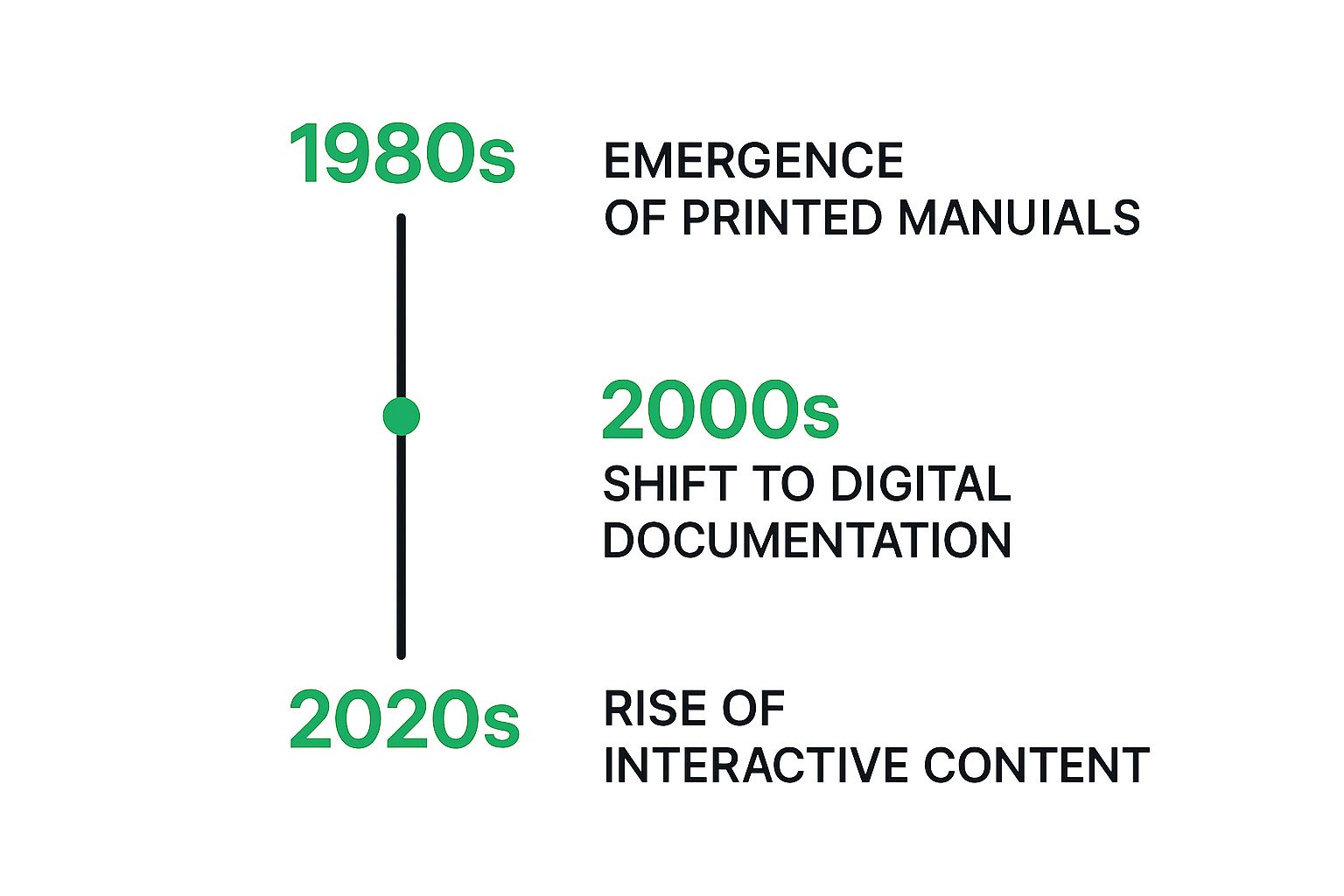Learn what is a technical communicator, their role in tech success, and how to start a career in this vital field. Discover more now!
Technical communicators explain complex technical information clearly and concisely. They create accessible content for various audiences, acting as the unsung heroes of the technology world. This crucial role has adapted significantly over time, responding to the constant changes in technology and user needs. But what exactly do they do, and why are they so important?
A technical communicator, also known as a technical writer, bridges the gap between complicated technical terms and everyday language. This profession became prominent during World War II because of the need for clear instructions for new military equipment. By the late 20th century, the rise of computers and software increased the need for technical communicators.
The U.S. Bureau of Labor Statistics predicted 12% job growth for technical writers between 2020 and 2030, higher than the average for all occupations. This growth shows how important clear documentation is for increasingly complex global products and services. More information on the future of technical writing is available here: Technical Writing Trends 2025. This evolution has made technical communicators key players in many industries, from software development to healthcare. You can learn more about technical communication here: What is technical communication?
The following infographic shows the evolution of technical communication, from printed manuals to today’s interactive content:

As the infographic shows, the field moved from mostly print documentation in the 1980s to mainly digital formats in the 2000s. Now, in the 2020s, it uses interactive and dynamic content. This change reflects wider technological progress and changes in how users get information.
Today’s technical communicators do more than just write user manuals. Their work includes a variety of content:
This wider range of work requires a diverse skillset. It combines strong writing with technical knowledge and an understanding of user experience.
Let’s look at a table summarizing the evolution of technical communication:
To understand how technical communication has changed, let’s examine a table summarizing the evolution of this field across different eras.
Evolution of Technical Communication Over Time This table shows how the technical communication profession has transformed through different historical periods and technological eras
This table shows the key shifts in documentation types, technologies used, and the main industries employing technical communicators. As technology evolves, so does the way information is presented and consumed.
Good technical communication is essential for several reasons:
By making information clear, concise, and easy to understand, technical communicators help users engage with technology. This contributes to a product’s success and business growth. They are key to making technology accessible and user-friendly in our increasingly complex world.
What distinguishes a truly exceptional technical communicator? It’s the ability to bridge the gap between complex technical concepts and clear, concise understanding. It’s about making technology accessible to everyone, regardless of their technical background. This unique blend of technical proficiency and communication mastery is what sets top communicators apart.
Strong communication skills are, unsurprisingly, at the heart of technical communication. This goes beyond perfect grammar and polished writing. It involves adapting your style to different audiences. Explaining a software feature to a developer, for instance, requires a different approach than explaining it to a customer. This adaptability is key to effective communication.
A solid understanding of technology is crucial. While it doesn’t require being a coding guru, it does mean grasping the fundamentals of the technology you’re documenting. This foundation allows communicators to ask insightful questions, understand complex processes, and accurately convey technical details. Familiarity with tools like MadCap Flare or Adobe FrameMaker is also becoming increasingly important.
Technical communicators are essentially researchers. They uncover information, analyze data, and synthesize complex topics into understandable narratives. This requires sharp analytical skills and a commitment to accuracy. Distilling intricate technical specifications into user-friendly instructions is a core part of the job.
Understanding your audience is paramount. Skilled communicators consider the user’s background, technical knowledge, and goals when creating documentation. This user-centric approach ensures that the information is tailored to their specific needs, maximizing its impact. Anticipating user questions and providing proactive solutions is a hallmark of this approach.
The tech world is in constant flux, requiring technical communicators to be adaptable and resourceful. They must readily learn new technologies and adjust their approach accordingly. This means embracing new tools and techniques while staying true to core communication principles. Strong problem-solving skills are essential for navigating complex documentation challenges.
Technical communicators rarely work alone. They collaborate with developers, designers, product managers, and other stakeholders. This requires strong interpersonal skills, including active listening and clear communication. Building positive working relationships is crucial for success.
This combination of technical understanding, clear communication, and a user-focused approach is what makes a technical communicator truly exceptional. They act as a bridge between complex technologies and the people who use them.

They make information accessible, understandable, and ultimately, valuable. Check out our guide on How to master essential technical writing skills.
Technical communicators often use visuals. Being able to effectively annotate a screenshot is a valuable skill.
The rise of digital technology has profoundly changed technical communication. Static manuals have given way to dynamic online help systems. These systems offer searchable content, interactive tutorials, and multimedia components. Technical communicators now create videos, animations, and augmented reality experiences to explain complex ideas, making technical content more accessible and engaging.
The audience and industry heavily influence the type of content a technical communicator creates. What works for healthcare documentation might not be appropriate for software development. Healthcare documentation often involves strict regulatory requirements and precise terminology. Software documentation, on the other hand, prioritizes user-friendliness and practical application. Technical communicators must be adaptable in their approach.
Technical communicators create a diverse range of deliverables:
Maintaining consistency across various content types is crucial. Technical communicators use style guides, terminology glossaries, and content strategies to ensure a unified voice and style. This creates a cohesive user experience regardless of the platform or format.

The future of technical communication is full of opportunity, with emerging fields like conversational interfaces and virtual reality training. These advancements require technical communicators to continually adapt and learn new skills, while upholding the core principles of clear, concise, and user-focused communication.
The following table, “Common Technical Communication Deliverables by Industry”, compares the primary types of documentation required across different sectors and their intended audiences.
This table illustrates how various industries utilize specific kinds of technical content, highlighting the diverse requirements of each sector. As technology evolves, so too will the demands of technical communication. The ability to adapt and embrace new challenges will be key for success.
Technical communication isn’t just about writing documentation; it’s about achieving real business results. Effective technical communicators bring quantifiable value to organizations, directly impacting the bottom line.
One of the most significant contributions of technical communicators is the reduction of support costs. Clear, comprehensive documentation empowers users to solve problems on their own, lessening the need for expensive support interactions. This translates into substantial savings, freeing up resources for other important areas. Well-designed documentation also streamlines onboarding for new users, boosting their productivity and reducing training expenses.
Technical communicators play a crucial role in driving product adoption. By creating user-friendly materials, they eliminate barriers to entry for new users, allowing them to quickly understand the value of a product or service. This faster adoption rate contributes directly to revenue growth and market share expansion. Furthermore, high-quality documentation significantly improves user satisfaction. When users can easily find the information they need, their overall experience improves, leading to greater loyalty and positive word-of-mouth referrals.
In many industries, user errors can lead to serious consequences, from financial losses to safety hazards. Accurate and effective documentation minimizes the risk of these errors by providing users with the information they need to operate products safely and correctly. This proactive approach prevents costly mistakes and ensures compliance with safety regulations, protecting both users and the business.
Technical communicators are essential for navigating the complex world of regulatory compliance. They ensure that documentation adheres to industry standards and legal requirements, reducing the risk of penalties and legal action. This is especially important in heavily regulated industries like healthcare and finance. Accurate and compliant documentation protects the organization’s reputation and safeguards against potentially damaging legal repercussions. The economic impact of technical communication is increasing, fueled by factors such as rapid technology adoption. For more insights on this trend, explore this resource: Discover more insights about the technology industry outlook.
Business leaders are increasingly recognizing the direct connection between strategic technical communication and measurable business outcomes. They understand that investing in quality documentation provides a substantial return on investment (ROI). This ROI can be measured through metrics such as reduced support tickets, higher customer satisfaction scores, fewer product returns, and faster product adoption rates. Technical communicators increasingly need to understand social listening to better tailor content to their audience. For a detailed guide, see Social Listening for Developer Tools.
Technical communication is no longer a back-office function; it’s a strategic imperative for businesses that want to succeed in today’s competitive market. By empowering users, preventing errors, ensuring compliance, and driving product adoption, technical communicators contribute directly to an organization’s overall success. Their ability to translate complex information into clear, actionable guidance makes them invaluable partners in achieving business goals. As technology continues to evolve, the role of the technical communicator will only become more important.
So, you’re interested in a career as a technical communicator? This field offers a rewarding journey, from entry-level roles to leadership positions. Whether you’re just starting out or aiming to advance your existing career, understanding potential growth paths is crucial for long-term success.
There are various ways to begin your technical communication career. A formal degree in technical communication, English, journalism, or a related field can provide a solid base. However, many successful technical communicators transition from other fields like software development, engineering, or customer support. These diverse backgrounds bring valuable skills, including technical proficiency, problem-solving abilities, and a customer-focused approach.
Building a portfolio that showcases your skills is vital, irrespective of your educational background. This portfolio might include writing samples, website designs, or even open-source project contributions.
Salaries for technical communicators depend on experience, industry, and location. Entry-level positions typically begin in the ****60,000 range. Senior roles can reach $100,000 or more. Specialized areas like API documentation and UX writing frequently offer higher salaries due to growing demand.
Resources like Glassdoor and Salary.com offer detailed salary data for specific locations and roles. Honing your negotiation skills is key to maximizing your earnings.
As the field progresses, specialized areas within technical communication continue to develop. API documentation is increasingly important as businesses rely more on APIs for software integration. UX writing, focusing on concise and user-friendly microcopy within digital products, is another rapidly expanding area. Information architecture, centered on organizing and structuring content for optimal usability, also presents opportunities for specialization. Focusing on one of these areas can make you a highly desirable candidate.
A typical career path might begin with a Junior Technical Writer position. With experience, you can advance to Technical Writer, Senior Technical Writer, and ultimately, Lead Technical Writer or Documentation Manager. Some technical communicators transition into related fields such as content strategy, UX design, or project management. Networking through organizations like the Society for Technical Communication (STC) can lead to new opportunities and mentorship.
The technical communication field is constantly evolving. Staying up-to-date with new technologies and industry trends is crucial for sustained success. This involves adopting new tools, exploring AI-powered documentation solutions like those from DocuWriter.ai, and developing skills in areas like content management systems and multimedia production.
Continuing education through online courses, workshops, and industry conferences helps you remain competitive. Building a strong professional network can provide valuable support and insight into emerging trends. By embracing continuous learning and adapting to the changing field, technical communicators can build rewarding and dynamic careers.
Technical communication is a constantly evolving field. It adapts to new technologies and changing user expectations. Several key trends are shaping the future of this profession. These include the rise of AI, the growing use of immersive technologies, and a shift towards user-centered content. These advancements create exciting opportunities for technical communicators who embrace change and develop new skills.
Artificial intelligence is rapidly transforming how we create and manage technical content. Tools like DocuWriter.ai automate generating code and API documentation. This saves developers significant time and resources. This automation frees technical communicators to focus on higher-level tasks.
These tasks include content strategy, user experience, and ensuring overall content quality. AI-powered tools can also analyze user data. This allows for the personalization of documentation, tailoring content to specific needs and preferences, ultimately improving user engagement and satisfaction.